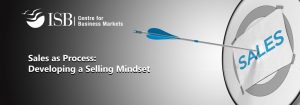
Webinar by Prof. Philip C. Zerrillo, Deputy Dean, Corporate Relations and Marketing Faculty at Indian School of Business (ISB)
Date: Wednesday, June 17, 2020
Compiled by Astha Sharma, Senior Manager, ISB-Centre for Business Markets (CBM)
It is not surprising that the sales staff in any organization are usually the best-paid group, since Sales is the most important vertical in any organization. Although the Covid-19 crisis may have forced salespeople to do their sales-call by leveraging technology, they still need to continue communicating with and sending out information to customers and potential customers.
Importance of decoding the firm’s selling process
It is not enough for the salespeople to only know the product or service they are selling. It is equally important for them to understand the selling process and make improvements to it. Companies focus a lot of their time in enhancing the efficiency of the selling process. At a high level, the selling process involves four keys steps:
1. Prospecting or lead generation
2. Preparation before pursuing the lead
3. Presentation to the lead
4. Follow-up
Different firms further break down these steps into sub-steps for better monitoring and quantifying the effectiveness of the selling process. In the following, a typical drill-down into two of the above four steps is presented to illustrate the need to deep dive into these four broad steps.
Lead Generation: The critical metrics of the lead generation process are the cost of generating the lead and quality of the lead. While firms want to optimize the cost of getting a lead, they also need to improve the quality of lead generated, as they do not want to invest their precious sales resources on poor-quality leads. For increasing the chances of lead conversion, often, managers allocate leads to the best-suited resources. These resources may not necessarily be the salespeople; they may include distributors, stockists, or others in the ecosystem of the firm who can best communicate with the lead.
Preparation before pursuing the lead: Also known as the pre-call planning process, preparation before pursuing the lead is vital. In this phase, the firm understands the lead’s background and needs in order to create a customized pitch, based on the information the sales team has garnered about that lead.
The most straightforward scenario in this process is when the presentation is being made to the existing customer for a current product. In contrast, the firm needs to have extensive preparation for making a pitch to a new customer, or for a new product, or both.
Companies are also interested in knowing more about the selling process as it helps them in forecasting their sales. With the development of technology, CRM tools like Siebel and Salesforce helped organizations track the selling process. Firms could track the number of leads generated, as well as those acted upon, and monitor the turn-around time to convert the lead to a sale. This data helps firms increase efficiencies and manage their selling process better. Imagine, after a marketing campaign, there were 100 leads generated. Out of these, there may be about 25 prospects, from which five may get converted to a sale. Understanding the entire selling process may help firms increase the number of prospects generated and increase sales conversions.
It is equally important for firms to focus on the customer’s buying process
While selling is an internal process, the buying process is customer-focused. The buying process enables the firm to look at the sale from the customer’s perspective. Such a customer-centric understanding is essential to ensure better chances of success in the selling process.
It starts with identifying what steps customers take, how often they take it, what difficulties they face in completing these steps, etc. This process helps firms in identifying the steps where it can contribute to the customer by understanding at a deep level, the challenges being faced by the latter. The buying process helps companies identify steps where they can create an impact on the customer.
The buying process can help companies:
1. Draw insights from the customer’s behavior
2. Understand the barriers in making the sale
3. Identify the enablers to make the sale
4. Identify situations where the supplier has failed to make the sale and the reasons for failure
5. Identify situations where the supplier has succeeded and the firm’s actions that contributed to the success.
Such fine-grained analysis will help the firm become a “learning organization” to improve the effectiveness of its selling process.
In our previous webinar on “Building firewall of relationship with Customers,” Mr. Rajesh Pandit mentioned that companies need to understand the evolving needs of the customer. Talking about the buying process, Dr. Z highlighted the importance of focusing on customers’ journeys while making a purchase.

